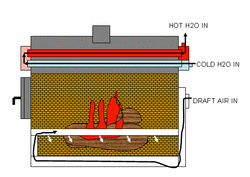Hello,
I have spent the past couple of weeks in my garage fabricating a new wood boiler for my house. I have the boiler built but need some help with the controls. I currently have a gas boiler installed that simply runs with 3 zone pumps and no valves. I want to run these pumps into the wood boiler, exit the wood boiler into the gas boiler and onto the heating system. Attached is a Crayola CAD drawing of the basic boiler layout. As you can see, the cold water comes in the bottom tubes and exits through the upper tubes as hot water. The draft air comes in a 6” pipe on the back of the boiler, down the back, under the coal bed, and is delivered via jetted tubes about 7.5” above the coal bed. The entire firebox is lined in brick up to the water jackets. I want the water temperature in the boiler to control the actuation of the damper, i.e. the temp reaches 200 degrees and the damper closes and at 160 degrees the damper opens. Can you recommend economical (eBay is OK) controls for accomplishing this? Also, I am going to run a line to a domestic water heat exchanger. Does this require it’s own circulatory pump to function effectively? If so, how is this pump actuated?
Thank you in advance for your help!
Tom
I have spent the past couple of weeks in my garage fabricating a new wood boiler for my house. I have the boiler built but need some help with the controls. I currently have a gas boiler installed that simply runs with 3 zone pumps and no valves. I want to run these pumps into the wood boiler, exit the wood boiler into the gas boiler and onto the heating system. Attached is a Crayola CAD drawing of the basic boiler layout. As you can see, the cold water comes in the bottom tubes and exits through the upper tubes as hot water. The draft air comes in a 6” pipe on the back of the boiler, down the back, under the coal bed, and is delivered via jetted tubes about 7.5” above the coal bed. The entire firebox is lined in brick up to the water jackets. I want the water temperature in the boiler to control the actuation of the damper, i.e. the temp reaches 200 degrees and the damper closes and at 160 degrees the damper opens. Can you recommend economical (eBay is OK) controls for accomplishing this? Also, I am going to run a line to a domestic water heat exchanger. Does this require it’s own circulatory pump to function effectively? If so, how is this pump actuated?
Thank you in advance for your help!
Tom


